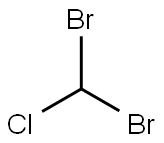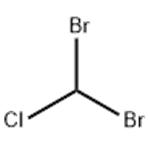
CHLORODIBROMOMETHANE
- Product NameCHLORODIBROMOMETHANE
- CAS124-48-1
- CBNumberCB0129381
-
MFCHBr2Cl
Lewis structure
- MW208.28
- EINECS204-704-0
- MDL NumberMFCD00000820
- MOL File124-48-1.mol
- MSDS FileSDS
Chemical Properties
| Melting point | −22 °C(lit.) |
| Boiling point | 119-120 °C748 mm Hg(lit.) |
| Density | 2.451 g/mL at 25 °C(lit.) |
| vapor pressure | 76 at 20 °C (Schwille, 1988) |
| refractive index | n |
| Flash point | 115-118°C |
| storage temp. | 2-8°C |
| solubility | acetone: soluble |
| form | liquid |
| color | Clear, colorless to pale yellow, heavy liquid |
| Water Solubility | Not miscible or difficult to mix in water. |
| Sensitive | Moisture & Light Sensitive |
| Merck | 14,2135 |
| BRN | 1731046 |
| Henry's Law Constant | In seawater (salinity 30.4‰): 2.78, 5.56, and 10.13 at 0, 10, and 20 °C, respectively (Moore et al., 1995) |
| CAS DataBase Reference | 124-48-1(CAS DataBase Reference) |
| EWG's Food Scores | 1 |
| FDA UNII | 3T4AJR1H24 |
Safety
| Symbol(GHS) |

|
|||||||||
| Signal word | Warning | |||||||||
| Hazard statements | H302 | |||||||||
| Precautionary statements | P264-P270-P301+P312+P330-P501 | |||||||||
| Hazard Codes | Xn,Xi,T,F | |||||||||
| Risk Statements | 22-39/23/24/25-23/24/25-11 | |||||||||
| Safety Statements | 45-36/37/39-26-36/37-16-7 | |||||||||
| RIDADR | 2810 | |||||||||
| WGK Germany | 3 | |||||||||
| RTECS | PA6360000 | |||||||||
| F | 8-10-21 | |||||||||
| TSCA | T | |||||||||
| HazardClass | IRRITANT | |||||||||
| PackingGroup | III | |||||||||
| HS Code | 29034980 | |||||||||
| Hazardous Substances Data | 124-48-1(Hazardous Substances Data) | |||||||||
| Toxicity | LD50 in male, female rats (mg/kg): 370, 760 orally (Aida); in male, female mice (mg/kg): 800, 1200 by gavage (Bowman) | |||||||||
| NFPA 704: |
|



